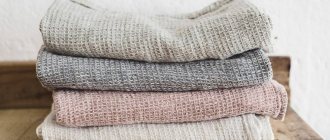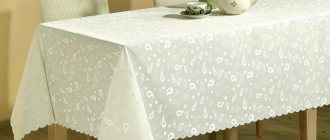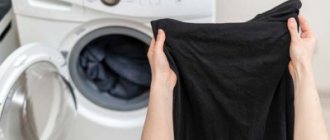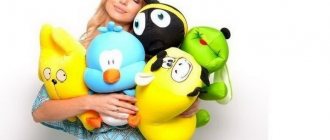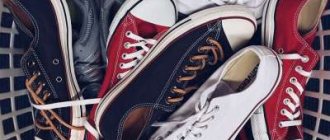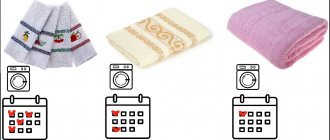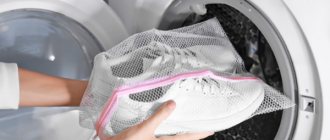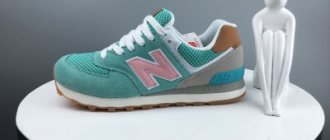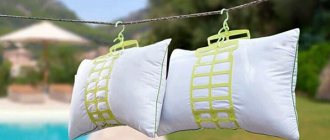Teflon tablecloths look very elegant, and at the same time are very practical. This material is not afraid of the sun and tolerates temperature changes. But in order for such a tablecloth to last as long as possible and not become covered with stains and stains, which often happens in the kitchen, you need to learn how to wash it correctly.
Teflon material has a special structure: the top layer is very dense and does not allow moisture to pass into the fibers. So there is no risk of getting wet for such kitchen textiles. The bottom layer is most often made of natural threads, and thanks to it the tablecloth has a high density and practically does not wrinkle.
How to care for a tablecloth?
Tablecloths
, which contain only polyester fibers or a mixture of them with cotton, it is recommended to wash them on a delicate cycle. The washing temperature should be no more than 40°C, otherwise the structure of the fabric will be damaged and its color will also fade.
Interesting materials:
How to install WeChat? How to set a video from gallery to wallpaper? How to install video on Samsung wallpaper? How to install video wallpaper on Android? How to set video wallpaper on Huawei lock screen? How to install video wallpaper on Huawei? How to set video wallpaper on Samsung? How to install video screensavers on Mac? How to install a video card on an HP laptop? How to install a video card in the system unit?
Proper care
A water-repellent impregnated tablecloth must be properly cared for, and then it will delight you with its newness and bright colors for a long time. Before washing such kitchen textiles in a machine, you should try to get rid of dirt using a regular wet cloth and soap. By washing the tablecloth from dirt using this method, you don’t have to worry about the integrity of the material and paint.
But how to wash a Teflon tablecloth correctly if it is very dirty and is it possible to do it at all? It is better to wash such textiles by hand. To do this, the product should be soaked in warm and soapy water. The optimal temperature for hand washing is about 40 degrees. It is recommended to use simple laundry soap or high-quality washing powder as a detergent.
If the product has become very dirty, greasy stains and stains have appeared on it, then you should use an intensive wash. First, the coating is washed directly on the table with a sponge and soap. You need to wipe the material until all the dirt comes off.
If the dirt is dry, it must be softened before washing. To do this, generously moisten all stained areas with a soap solution using a rag, and leave the product for an hour. After an hour, you can easily remove all the dirt with a cloth.
Silk
Silk is considered a sign of wealth and chic. And it is worth caring for it properly.
Care:
- It is advisable to wash silk with a special program, or in a gentle cycle at a temperature of no more than 40 C.
- Do not use bleach.
- Dry only in air; doing this in a washing machine is strictly prohibited. Drying this way may cause color loss.
- Also, do not use chlorine-containing substances.
- It is better to iron silk in a special mode intended only for silk, or at 120 C.
- If the tablecloth has embroidery, it should be ironed from the inside out.
Removing stains: If you remove wine stains from a tablecloth immediately, then not a trace will remain of them. Simply blot the contaminated areas with a sponge and warm water. If you do not remove it immediately, it will turn brown and it will no longer be possible to remove it. But you can try to do this with glycerin. Wipe with glycerin, then rinse the area in warm water.
Teflon coated tablecloth: a complete description of the pros and cons
High-quality textiles for table setting must meet several main criteria, namely, look aesthetically pleasing, be practical, and last a long time. A Teflon coated tablecloth meets these requirements.
After all, the most exquisite and expensive linen tablecloths in terms of practicality can cause grief for the housewife. If you spill sauce, coffee, or wine on them, such an incident does not always pass without a trace.
Not all, even the most expensive, detergents can restore the original appearance of a stained tablecloth.
Textiles made from synthetic fabrics are more protected from stubborn stains, but their appearance immediately reveals the price category of the product. Innovative technologies have made it possible to create a unique product - a Teflon-coated tablecloth, which is resistant to any contamination and is in no way inferior in style to the most famous products made from natural fabrics.
Teflon-coated tablecloths can be made from the same materials as regular kitchen textiles:
What is Teflon coating: how is it applied?
A Teflon-coated tablecloth is often called a “Teflon tablecloth,” and then owners are disappointed that Teflon is not some special fabric, but just a processing of the same cotton or synthetic fabric. This is impregnation with a special substance PTFE (polytetrafluoroethylene), discovered in 1938 in New Jersey, at the DuPont Jackson Laboratory.
Teflon coating is applied to the product at the end of the manufacturing process, or textiles are sewn from finished fabric that is subject to preliminary chemical treatment. Different manufacturers organize this process in their own way, but there are only two options.
The chemical PTFE is applied in the form of an aqueous solution. The method of application is dipping in plush, followed by fixing the preparation and drying the fabric.
Only the fibers of the fabric are saturated evenly, all the “gaps” between the threads remain, that is, the fabric does not lose properties such as breathability.
This is the difference between Teflon treatment before applying a continuous water-repellent film, which closes the “holes” between the threads and prevents air penetration.
Teflon tablecloth: characteristics, advantages and disadvantages
Teflon-coated kitchen textiles have excellent consumer characteristics and a lot of advantages. It also has properties that can be considered disadvantages if you do not take them into account in everyday use.
It was noted above that a Teflon-coated tablecloth can be made from different fabrics, so it is suitable both for serving a festive table on the most special occasions, and for daily use on the kitchen table.
It all depends on the choice of material and its color. Natural fabrics of pastel colors, with a complex patterned weave of threads, will help create a sophisticated atmosphere in the living room.
Cotton fabrics with a “fun” print are suitable for the kitchen, as well as for setting the table for a picnic lunch.
The main advantages of Teflon impregnation of products for kitchen textiles:
If you have an opinion about what a wonderful tablecloth this is, do not be disappointed when you learn that you cannot do without some nuances of use. You may consider them as disadvantages, but in any case, such a tablecloth has many more advantages.
Disadvantages of a Teflon-coated tablecloth
How to choose a Teflon-coated tablecloth
Considering the advantages and disadvantages of Teflon-coated kitchen textiles, many users decide that they should choose an expensive tablecloth from a reputable manufacturer, and the disadvantages will be avoided. But it is not so. The need to carefully and promptly clean the tablecloth and the abrasion of the coating due to frequent washing do not depend on the textile manufacturer. Depends on the manufacturer:
There are many manufacturers offering Teflon tablecloths at different price points. For example, inexpensive tablecloths that Russian consumers love:
To create a stylish interior, expensive tablecloths made from high-quality natural jacquard fabrics impregnated with Teflon from the following manufacturers are ideal:
Most manufacturers from Turkey or Taiwan offer both inexpensive products for everyday use and festive kitchen textiles.
In addition to individual tablecloths, you can order sets that include table napkins in quantities of 6, 8 or 12 pieces.
Features of caring for kitchen textiles with Teflon impregnation
One of the advantages of Teflon tablecloths is ease of care and preservation of appearance with frequent use. All this does not negate compliance with several rules for using such textiles.
1Rule one. It is better to eliminate the consequences of liquid spills immediately. As soon as you notice a stain on the tablecloth, use a soft napkin, paper or fabric, to gently blot up all the liquid. There will be no traces of liquid left, you will not get dried stains that will have to be soaked. 2Rule two. If you notice too late a spilled liquid or food residues that have dried out, do not use abrasives or aggressive detergents that can damage the integrity of the Teflon layer. It is enough to moisten the stain with warm water, wipe off any remaining food or liquid with a cloth or microfiber cloth, wipe the tablecloth with a clean damp cloth, then with a dry cloth. 3Rule three. Try not to wash the tablecloth too often. After about six washes, the Teflon coating will begin to thin out, lose its integrity, the tablecloth will become more dirty, and it will be more difficult to wash it.
If you decide to wash a Teflon-coated tablecloth:
After washing, the tablecloth may shrink by several centimeters, even if the base fabric is not subject to shrinkage. Therefore, it is important to take this fact into account when buying a tablecloth; it is better to take the size of the product with some margin for possible changes in size. A tablecloth, the edges of which protrude less than 15-20 cm onto the edge of the tabletop, looks unpresentable.
If your tablecloth has lost its attractive appearance or has become so dirty that it has to be washed after each use, it is better to replace it with a new one.
At the same time, a product that was used to serve a holiday or dinner table can be tried to be used at the dacha or for picnics, where the presence of small, unnoticeable stains is not critical.
After all, even if the protective coating itself has partially lost its properties, the base fabric can remain of just as high quality.
Users who bought a Teflon-impregnated tablecloth give only positive reviews about their purchase. Here, for example, is what they write about this product on the Otzovik website.
The Seven Teflon tablecloth cost me only 60 rubles. I bought it by pure chance; the store advertised it as a high-quality, affordable product for the kitchen. I decided to try it, because my oilcloth was already worn out, and a new one was more expensive than this tablecloth.
I was surprised how wonderful this item is for the kitchen. My kids eat breakfast on the go and always spill or knock something over. I had to quickly wipe the table, but there were still a few stains on the tabletop.
The new tablecloth does not let water and tea through, does not get dirty after spilled soup, and looks wonderful.
The size of 1.6 by 1.2 m turned out to be too big for my kitchen table, I had to bend the tablecloth a little. Otherwise, it's an excellent choice.
The tablecloth was chosen to match the color of the wallpaper. They look very stylish to me. But that was the problem. Ordinary oilcloth looked too cheap next to it, and textile tablecloths got dirty too quickly and lost their attractive appearance. I decided to try a tablecloth with a Teflon coating.
I read a lot of reviews from satisfied owners of the miracle tablecloth, and decided to go for it. Moreover, 65 rubles is not too much money. But it turned out that this tablecloth is even better than what was written about in the reviews.
I managed to choose a color that was very close to the wallpaper pattern, fortunately there is a very large selection.
It is true that the tablecloth is very easy to care for and practically does not get dirty. I’m used to removing all the stains and crumbs from the table at once, without allowing them to dry out. Therefore, in six months I have never had to seriously clean the tablecloth; I just wipe it with a slightly damp cloth. This tablecloth makes my kitchen look festive and I really enjoy staying here longer.
I noticed that I even began to cook with great pleasure. You can also place a hot plate on this tablecloth without using stands, it’s so convenient, especially with three children.
Trade brands “Skatertishop” (Moscow), “Kupchikha” offer different types of Teflon tablecloths made of linen, cotton, mixed fabrics, and polyester. We will talk about the features of such serving textiles. The practical canvas is appropriate on large tables during family dinners, will make the kitchen cozy, and will add bright colors to a picnic.
Among the wide variety of Teflon-coated serving textiles, you can find natural tablecloths for the festive table in pastel colors, plain and with small patterns. The products have an elegant look and are suitable for the most special occasions. Polyester amazes with a riot of colors. Bright sunflowers in a kitchen with windows facing north will enliven the interior, adding warm colors and light to it. Cotton tablecloths with an original, unusual print or thematic design will be appropriate in cafes and canteens; they will lift your spirits and enliven the atmosphere of a spacious room. The trend is for Teflon tablecloths for round tables; they are decorated with a border and fall from the edges with raised folds. Available in various styles.
The products have an elegant look and are suitable for the most special occasions.
The right choice: where to start
Main selection criteria:
A tablecloth and chair covers made in the same style are well suited for a Provence or country kitchen.
The drawing should also be in harmony with the general background. For example, if the wallpaper has a small pattern, then a tablecloth with a similar pattern will blend in with the walls. White, cream and pastel colors remain universal. They will fit well into any environment. For a country-style kitchen, straw-colored fabrics with floral patterns are more harmonious. For high-tech and modern styles, choose gray and black canvases with geometric patterns.
In addition to the tablecloth, it is recommended to purchase napkins for the kitchen. Often fabric napkins are sold complete with a tablecloth. They vary in composition and shape. The fabric napkin can match the color of the tablecloth, but it is better that they differ in shade. The exception is napkins in white, cream and pastel colors. The material of the napkin should match the tablecloth. They are durable and will protect the table from damage.
We suggest you familiarize yourself with How to clean the stove: cleaning the grate, oven, hob, handles, removing grease and carbon deposits
Ironing options
Such products cannot be ironed. If you dry the washed tablecloth properly, straightening out all the folds and creases well, then it will not need ironing. Such tablecloths practically do not wrinkle during use.
But if you cannot do without an iron, then the product should be ironed from the wrong side through cotton fabric. The heating temperature of the iron should be minimal.
By following simple recommendations and caring for a water-repellent tablecloth correctly every day, you can significantly extend its service life. By properly washing and wiping the table covering, you will preserve the brightness of the colors of the design and will not spoil the impregnation. Careful handling of kitchen textiles is the key to durability.
Detergents
To prevent such products from losing their brightness due to frequent washing, you should choose the right detergent. Firstly, the compositions must be soap-based and produce foam. It is advisable to choose washing powders for newborns, as they contain less chemicals that corrode the water-repellent coating.
A Teflon tablecloth will never deteriorate from 72% brown laundry soap and children's washing powder. What products are best to buy?
| Children's soap "Eared nanny" |
| Soap powders for newborns |
| Baby powders brand “Our Mom” |
Is it possible to wash such products in a machine?
Often housewives simply do not want to waste time and effort on hand washing and ask whether it is possible to wash a tablecloth with water-repellent impregnation in an automatic washing machine. This can be done, but very rarely, since machine washing literally two or three times will simply kill the item.
If you still decide to do laundry in a machine, then follow these tips:
- Choose the most gentle wash. This can be the “Wool” or “Silk” mode. If there are no such programs, then install hand wash.
- The spin cycle in the machine must be turned off. Such things should never be squeezed out in a drum.
- The water temperature for washing the product should in no case exceed 40 degrees. It is advisable to set the temperature to 30 degrees.
- Washing powder is poured into the compartment in a minimal amount. It is best to take liquid gel for washing delicate items.
- All that remains is to start the wash and wait for the result.
When the machine stops, you need to carefully remove the tablecloth from the drum and lay it out on the dryer or hang it on the clothesline to dry. You can also dry the item in a horizontal position, laying it on the floor on an old sheet.
Expert opinion
Kristina Samokhina
Experienced housewife.
Please note that when washed in warm water, a Teflon tablecloth may shrink a little. This happens most often if the base of the product is 100% cotton. Tablecloths on an expensive base usually do not shrink.
Wash by hand
Once the tablecloth is cleaned with a rag, you can wash it by hand to remove all stains. To do this you need:
- Dissolve 1-2 tbsp in a bowl of warm water. l. washing powder or washing gel.
- Immerse the product in water and leave it to soak for half an hour.
- Next, the tablecloth is carefully wiped with a napkin or sponge. Do not use the abrasive side of the sponge when washing.
- All that remains is to rinse the washed tablecloth in plenty of water. It’s convenient to do this in the bathroom. You can also use the shower.
- Under no circumstances should the product be twisted. The tablecloth is hung over the bathtub on a clothesline and left to drain the water and allow the material to dry completely.
- Such items can only be dried naturally at room temperature.
Teflon
This material has a special type of weave of fibers, where their top layer does not allow moisture to pass through, which is why the product does not get wet. The basis for such tablecloths is linen or cotton, on which a Teflon layer is applied.
The finished product is processed with it at the final stage of its creation.
Important! In addition to water-repellent properties, Teflon tablecloths are resistant to high temperatures. For example, you can easily place hot pots on such tablecloths or not worry about accidental cigarette ash leaving a mark.
Wet cleaning
So, there are several ways to remove stains from a tablecloth. First of all, you can clean the tablecloth in the most trivial way - by soaking the dirt directly on the surface, without using any special products for the tablecloth material. So, an ordinary stain remover is perfect, as well as soap applied in a thick layer until a voluminous foam forms. Next, you can use some not very sharp hard object to remove the dirt itself. Afterwards, you need to remove the remaining products and wipe the surface dry - the remaining droplets of moisture will soon evaporate, and the tablecloth will shine again, as if nothing was on it.
If you want to carefully clean the front side without using significant physical force, use an ordinary damp cloth. Can be used together with various cleaning agents. With proper and constant care, your tablecloth will always be in order, and timely wet cleaning will prevent dried stains from forming.
Such regular care can extend the life of the product without using a washing machine for as long as possible. But wet cleaning also has its disadvantages - sometimes it is impossible to remove even a fresh stain if the substance is very caustic or dries quickly. Therefore, this method is the main maintenance part for a relatively clean tablecloth that does not need to be washed in the near future.
Advantages and disadvantages of Teflon-coated products
First, the good stuff. The advantages of Teflon treatment are obvious; the coating protects the fabric from food particles:
Teflon-impregnated material differs:
Over time, the colors do not fade, they are not afraid of ultraviolet radiation. Now about the bad, a Teflon-coated tablecloth is not ideal. There are some disadvantages to impregnated serving textiles. The main drawback is that the coating does not last forever; it lasts in the kitchen for 5–6 years. Holiday models have a much longer service life and are used less often. Care means a lot. Due to dry cleaning and machine washing, Teflon loses its durability, microcracks, defects appear on it, and stains that are difficult to remove appear. With the right treatment and proper cleaning, Teflon-impregnated fabric remains practical for a long time.
The main drawback is that the coating does not last forever; it lasts in the kitchen for 5–6 years.
Removing difficult stains
Red wine. If you notice red wine spilled on the table, act immediately. First, the stain should be blotted with napkins, and then rubbed with a wet sponge, which must be rinsed constantly. Then several napkins are placed under the stain, and the stain is covered with napkins on top so that the remaining wine is absorbed into the paper. It is advisable to press the napkins with something heavy, for example, a large plate.
When the guests go home, you can wash the tablecloth. It is best to remove red stains with antipyatin soap or high-quality washing powder. If wine stains were discovered after the feast, then try to get rid of them with salt. Mix salt and water to make a paste. Then apply it to the stains and leave for an hour or two. After this, the item can be washed with powder.
Coffee and tea. You can get rid of hot drink stains on various fabrics using vinegar. A tablespoon of vinegar is diluted in a glass of water and soaked in a solution of contamination. You can also try ammonia. Ammonia is a good option for cleaning a linen tablecloth from coffee and tea.
Fat. Fat is very difficult to remove from fabrics, and even a small greasy spot can completely ruin the festive look of the item. You can try sprinkling salt, starch or baking soda on grease stains. You should wait a little until the fat is absorbed into the powder, and then cover the stain with paper and iron it with a hot iron. After the holiday, the product can be washed with detergent.
It is impossible to imagine a festive feast without a beautiful tablecloth. But when the dishes are taken to the kitchen, the housewives notice various stains on the tablecloth. Don’t waste time, but immediately start removing dirt, and then your holiday tablecloth will serve you longer.
SIMILAR ARTICLES:
Reading time: 3 minutes. Published 01/13/2020
A tablecloth is an indispensable attribute of any holiday and celebration. In addition to aesthetic qualities and creating an atmosphere, such products also have a practical benefit - they protect the table surface from contamination.
This is especially true for coatings with special water-repellent impregnation. Such products effectively remove moisture from the base material and reduce its wear. How to wash a Teflon tablecloth to protect the product from rapid wear and tear?
